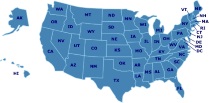Native Americans
Things to See & Do in Oklahoma
Chickasaw National Recreation Area
The “Peaceful Valley of Rippling Waters” appropriately describes Chickasaw National Recreation Area, as it is known for its many mineral springs, cool water, flora, fauna, and wildlife. Here one’s mind may wander back in time to when the early American Indian came to this area to rest, relax at the water’s edge, and hunt for their food from the abundant wildlife. This area has significant geological and hydrological features and lies in the transitional ecotones of the Eastern deciduous forest and the Western prairies.
Fort Smith National Historic Site
At Fort Smith National Historic Site you can walk where soldiers drilled, pause along the Trail of Tears, and stand where justice was served. The park includes the remains of two frontier forts and the Federal Court for the Western District of Arkansas. Exhibits in the visitor center focus on Fort Smith’s military history from 1817 – 1871, western expansion, Judge Isaac C. Parker and the federal court’s impact on Indian Territory, U.S. Deputy Marshals and outlaws, Federal Indian policy, and Indian Removal including the Trail of Tears. Located on the grounds are the foundation remains of the first Fort Smith (1817-1824), the Commissary building (c. 1838) and a reconstruction of the gallows used by the federal court. A walking trail along the Arkansas River includes wayside exhibits on the Trail of Tears.
Washita Battlefield National Historic Site
Washita Battlefield National Historic Site protects and interprets the site of the Southern Cheyenne village of Peace Chief Black Kettle that was attacked by the 7th U.S. Cavalry under Lt. Col. George A. Custer just before dawn on November 27, 1868. The controversial strike was hailed at the time by the military and many civilians as a significant victory aimed at reducing Indian raids on frontier settlements. Washita remains controversial because many Indians and whites labeled Custer's attack a massacre. Black Kettle is still honored as a prominent leader who never ceased striving for peace even though it cost him his life.
Trail of Tears National Historic Trail
The Trail of Tears National Historic Trail commemorates the removal of the Cherokee and the paths that 17 Cherokee detachments followed westward. Today the trail encompasses about 2,200 miles of land and water routes, and traverses portions of nine states.
Featured Resources
As an Amazon Associate, we earn from qualifying purchases. We get commissions for purchases made through links on this site.
The Successful Homeschool Family Handbook
If you are thinking about homeschooling, or are struggling with a educational homeschooling curriculum that is difficult to use, let Dr. Ray and Dorothy Moore show you how to make homeschooling an easy-to-live-with family adventure in learning. This low-stress, low-cost program shows you how to build a curriculum around your child's needs and interests - and around a realistic family schedule. Instead of a cut-and-dried approach, you'll discover the freedom of a flexible program that encourages ...
Real Lives: Eleven Teenagers Who Don't Go to School
Grace Llewellyn, author of the The Teenage Liberation Handbook, offers the stories of 11 teens who made the decision to reject traditional schooling methodologies and take their education into their own hands. The essays highlight offer a day-in-the-life look at teen homeschooling and unschooling, as the teens embraced self-education and increased in their self-confidence and motivation.
Pecci Reading Method: At Last! A Reading Method for Every Child
At Last! A Reading Method for Every Child offers a balanced approach with intensive phonics and literature-based reading instruction. This is a simple method of teaching reading, with lots of supplemental materials. Get product information here.
Drawn Into the Heart of Reading
Drawn Into the Heart of Reading was developed for use with students of multiple ages at the same time, perfect for the homeschooling family. It is designed for use as an entire reading program or as a supplement to an existing program for students in grades 2-8.
Reading Made Easy
Reading Made Easy is a phonics-based program, featuring 108 easy lessons, designed to be taught in less than 30 minutes per day. It is fully scripted and has original Christian content and stories. Includes hands-on writing and drawing activities. Reading Made Easy can be purchased here.


